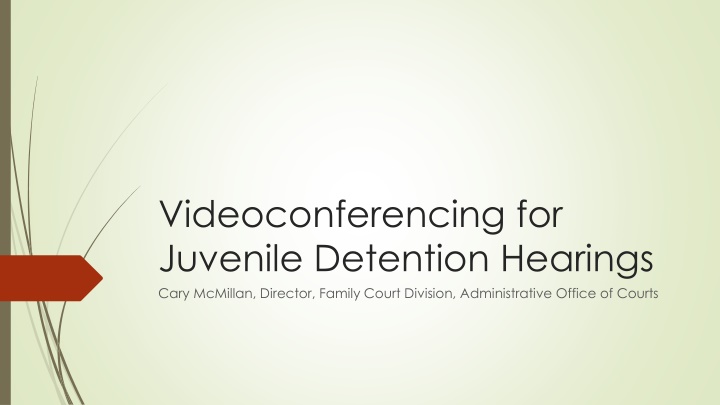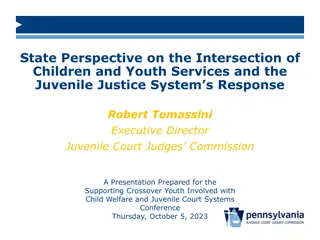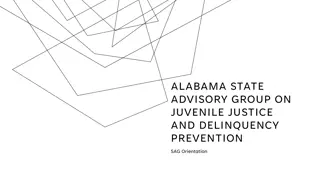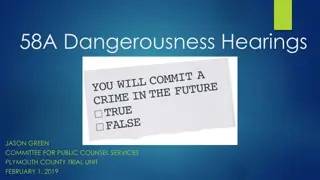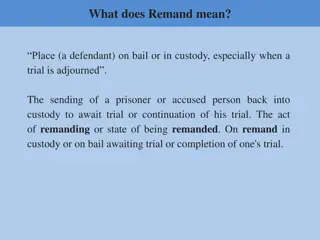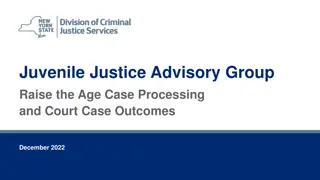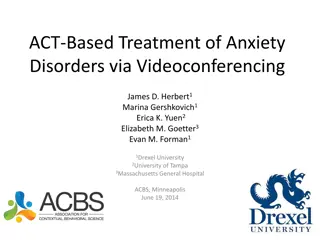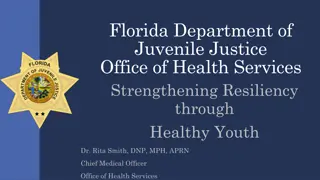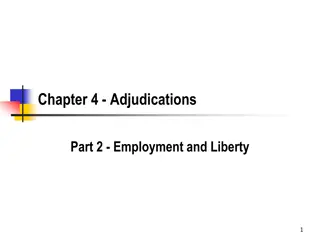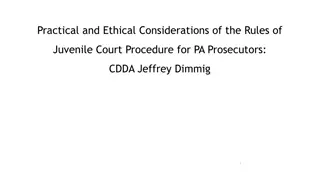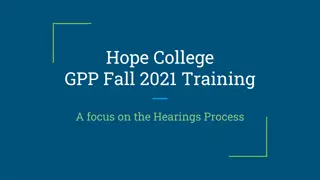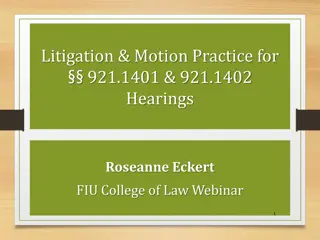Enhancing Juvenile Detention Hearings Through Videoconferencing
Videoconferencing for juvenile detention hearings aims to improve efficiency by allowing participants to communicate remotely, reducing the need for physical transportation of juveniles to court. The project establishes a reliable alternative to juvenile transportation, enabling juveniles to attend hearings without being physically present in the courtroom. Guidelines ensure confidentiality and proper procedures are followed.
Download Presentation

Please find below an Image/Link to download the presentation.
The content on the website is provided AS IS for your information and personal use only. It may not be sold, licensed, or shared on other websites without obtaining consent from the author.If you encounter any issues during the download, it is possible that the publisher has removed the file from their server.
You are allowed to download the files provided on this website for personal or commercial use, subject to the condition that they are used lawfully. All files are the property of their respective owners.
The content on the website is provided AS IS for your information and personal use only. It may not be sold, licensed, or shared on other websites without obtaining consent from the author.
E N D
Presentation Transcript
Videoconferencing for Juvenile Detention Hearings Cary McMillan, Director, Family Court Division, Administrative Office of Courts
Introduction Videoconferencing is a process by which participants in a judicial hearing can communicate with each other and with the court from separate locations. Videoconferencing has the potential to reduce travel requirements for law enforcement officers who are charged with the duty of transporting children in juvenile cases between juvenile detention facilities and courts.
Introduction (continued) The objective of the videoconferencing project is to establish a reliable alternative to juvenile transportation, while ultimately increasing the efficiency of the juvenile justice process. Videoconferencing will permit the child in a juvenile delinquency case to attend specified hearings without physically appearing in the courtroom. Source: Alabama Judicial System Policies, Procedures and Guidelines Governing Videoconferencing Appearances in Juvenile Courts (9/2009)
Pilot Counties Under the Guidelines (through September 30, 2017) Lauderdale Marshall Morgan
Guidelines for Videoconferencing Detention Hearings (Temporary) All proceedings must conform to the Guidelines for Videoconferencing Detention Hearings (Temporary) (A) Appearance of Child by Videoconferencing. The court in its discretion may direct the child to appear at a detention hearing by videoconferencing technology. Upon written consent by the child and the child s attorney, a plea and disposition may be entered by videoconference. The child s appearance by videoconferencing shall be considered a personal appearance. The court has the discretion to order the child to physically appear.
Guidelines for Videoconferencing (continued) (B)Confidential Communications. If the hearing is held by videoconference, provision shall be made to preserve the attorney-client privilege and the confidentiality of attorney-client communications. In all proceedings by videoconferencing, private means of communication shall be available when they are in different locations, and attorneys shall have means of conferring with each other with the court off of the record.
Continued (C)Location of the Child s Attorney in Hearings Held by Videoconferencing. During a hearing conducted by videoconference pursuant to these guidelines, the child s attorney may be present with the child at the detention center or the attorney may be present physically in the courtroom. (D) Other Persons in Attendance at Hearings Held by Videoconferencing. Unless otherwise ordered by the court, other persons admitted to attend a hearing conducted by videoconferencing pursuant to these guidelines, other than the child and the child s attorney, shall appear in person before the court.
Continued (E)Electronic Filing of documents. Any documents filed during a hearing conducted by videoconferencing may be transmitted electronically. A document transmitted electronically may be served on or executed by the person to whom it is sent and returned in the same manner, with the same force effect, authority, and liability as any other original document.
Continued (F) Technical Standards. To facilitate the compatibility of equipment, all videoconferencing equipment used in implementing these guidelines must be approved by the Administrative Office of Courts and meet the following minimum requirements: 1. All participants in the hearing must be able to see, hear and communicate with each other simultaneously; and 2. All participants in the hearing must be able to see, hear and otherwise observe any physical evidence or exhibits presented during the hearing, either by video, facsimile, or other method.
Continued (G) Recording and Preservation. The portion of the hearing conducted by videoconferencing shall be recorded by an audiovisual recording system, and that recording shall be part of the record of the case. -Source: Appendix B Guidelines for Videoconferencing Detention Hearings (Temporary)
Appearances by Videoconferencing The juvenile court has the discretion to use videoconferencing technology to conduct detention hearings pursuant to 12-15-207, Ala.Code 1975. Additionally, the court may receive pleas and enter dispositions on a juvenile delinquency case, but only upon receiving written consent from the child and child s attorney.
Convening a Hearing by Videoconferencing A. All juvenile court hearings conducted by videoconferencing shall be recorded by stenographic reporting, by mechanical or electronic device, or by some combination thereof pursuant to Rule 20(A), Alabama Rules of Juvenile Procedure. B. The juvenile court judge or referee must identify the person appearing by remote testimony and then identify him/herself.
Convening a Hearing by Videoconferencing (continued) C. The juvenile court judge or referee must assess the quality of the videoconferencing connection by asking the participants the following: 1. Are you able to hear me and can you understand what I am saying? 2. Are you able to see me and is the picture quality sufficient? 3. If at any time you are not able to see or hear what is happening in court today, you shall immediately inform me of the issue. 4. Even though you are participating in this hearing by videoconferencing, you must conduct yourself in the same manner as if you were physically present in court. 5. Other than the child and the attorney, who else is in the room with you?
Convening a Hearing by Videoconferencing (Continued) D. The juvenile court judge or referee must identify for those appearing from a remote location each individual located in the courtroom. During the identification process, the juvenile court judge or referee must verbally identify the location of each party as they appear on the monitor, so that all participants can distinguish the other participants. E. The juvenile court judge or referee must make a determination and make a record as to whether the equipment to be used and the remote location(s) meet the minimum standards for video appearances approved in writing by the Administrative Office of Courts.
Continued F. At the commencement of the hearing, the juvenile court judge or referee must assure that only one person speaks at a time. G. The courts must follow the guidelines set forth by the orders of the supreme court and adhere to all laws and court rules applicable to the juvenile court of Alabama.
Location of the Childs Attorney The temporary guidelines allow the child s attorney to appear in person before the court or to be present with the child at the juvenile detention facility and appear by videoconferencing. The juvenile court judge or referee in the county where the hearing is conducted may appoint counsel located in the jurisdiction of the juvenile detention facility. This subsection would permit the appointed counsel to be present with the child at the juvenile detention facility and appear at the hearing by videoconferencing.
Electronic Filing of Documents and Signature Issues At the commencement of a hearing conducted by videoconferencing, the participants may transfer documents by electronic means. The juvenile court judge or referee many use any of the following means to accommodate the transmission of documents between individuals in separate locations: a. Fax - The juvenile court and juvenile detention facility may be equipped with a fax machine. The court and the child s attorney can transmit pleadings, court documents, and other filings over the fax machine. A signature appearing on a faxed document shall be considered an original signature.
Continued b. Electronic mail - Documents may be transmitted between the participants remote location and the juvenile court by electronic mail. Documents can be completed on a computer and transmitted between the participants. Additionally, paper documents may be scanned in. at the
Electronic Filing of Documents and Signature Issues (continued) The requirement that any court record or document be signed is met by use of an electronic signature. An electronic signature is considered to be the original signature upon the court record or document for all purposes under these rules and other applicable statues or rules. Electronic signatures shall either: (1) show an image of such signature as it appears on the original document or appended as an image file, or (2) bear the name of the signatory preceded by s/ typed in the space where the signature would otherwise appear, as follows: s/Jane Doe, or (3) comply with any other requirements for electronic signatures as established by law on Administrative Director of Courts directive.
Videoconferencing Equipment All videoconferencing equipment used by counties participating in the pilot project must be approved in writing by the Administrative Office of Courts. -Source: Alabama Judicial System, Policies, Procedures and Guidelines Videoconferencing Appearances in Juvenile Courts (9/2009)
